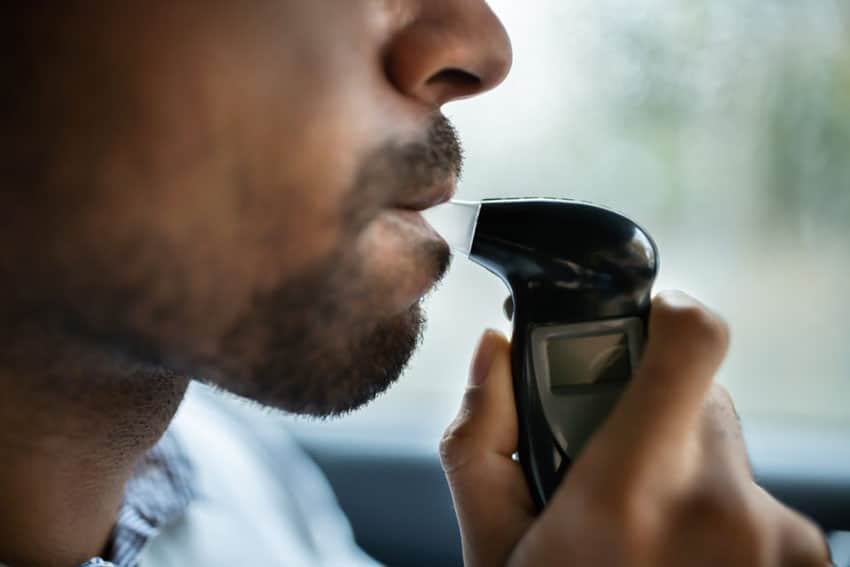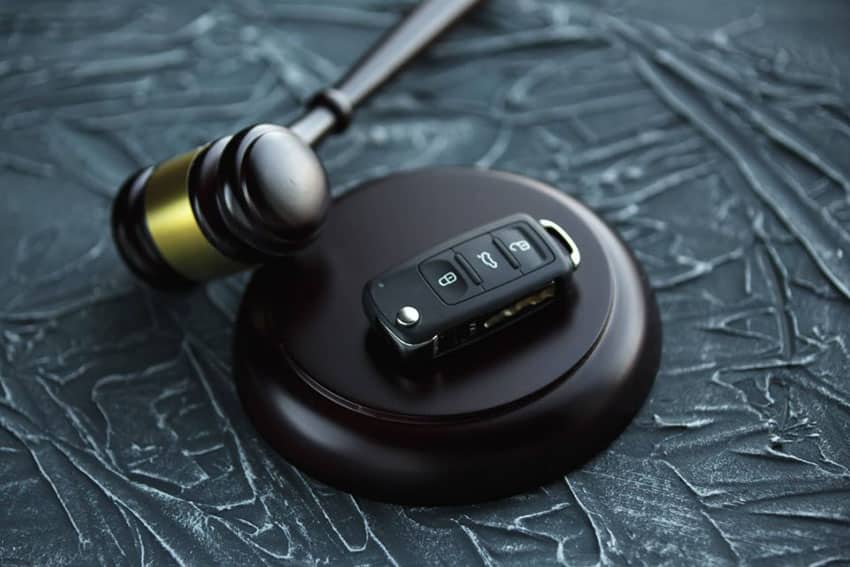Traditionally, law enforcement authorities have requested that motorists suspected of intoxication perform sobriety tests, such as walking a straight line, putting a finger to the nose, or balancing on one foot, in order to corroborate their conclusion of intoxication of the motorist based on objective findings. In addition to any physical tests, chemical tests for intoxication are commonly used to either bolster and corroborate police opinion testimony of intoxication or, in those states that set presumptive blood alcohol intoxication levels, to demonstrate that a motorist’s blood alcohol level exceeded the permissible level. Due to its portability, the handheld breathalyzer machine is the most common chemical testing device used to determine a driver’s blood alcohol content (BAC).
The Breathalyzer, which is the most commonly used BAC tester today, was invented in 1954. It detects and measures the level of alcohol on a person’s breath with the use of a chemical reaction. A breathalyzer test kit contains several vials of chemicals of differing colors that change color when they come into contact with alcohol. The color changes indicate the amount of alcohol. A breath test to measure blood-alcohol level, administered with an approved device, is required in many states for persons operating motor vehicles involved in accidents, or which are operated in violation of any traffic laws.
In New York State, it is illegal to operate a vehicle with a BAC over .08. If the driver is under the age of 21, the limit is .02.
New York’s implied consent law states that any person who operates a motor vehicle in the state shall be deemed to have given consent to a chemical test of one or more of the following: breath, blood, urine, or saliva, for the purpose of determining the alcoholic and/or drug content of the blood. Thus, you give consent to a chemical test simply by driving in the state.
If a person is lawfully arrested for a DWI and refuses to submit to a BAC test in New York State, they will be subjected to mandatory civil fines and driver’s license suspension. The penalties for refusing to take a BAC test are in addition to the standard penalties for DWI. Even if a suspected DWI offender is acquitted of DWI charges, they will still face these penalties:
- Chemical Test Refusal: Mandatory 6 month license suspension and $300 civil fine
- Chemical Test Refusal Within 5 Years of a Previous DWI Related Offense: Mandatory one year license suspension and $750 civil fine.
Breathalyzer tests have been upheld in the courts as not constituting unreasonable searches and seizures, although the tests may constitute a “search” within the meaning of the Fourth Amendment. The courts have generally found that a suspected DWI offender has no constitutional right to refuse to take a breathalyzer test.
Courts in New York have upheld the admissibility of breathalyzer results. In the case of People v. Singh, the court found that results of a breathalyzer are admissible in court if they present competent, reliable and probative evidence that the defendant was impaired or intoxicated when they operated a vehicle.
The DWI attorneys at the law firm of DWI Team Defense Attorneys are experienced in handling DWI cases. If you need a lawyer who can help you obtain the best possible outcome in your DWI case, call the law firm of DWI Team Defense Attorneys.
Understanding the Intoxilyzer 5000
In New York, there are three forms of testing that are acceptable under the DWI chemical testing statute: testing by blood, breath, or urine. Because the results are immediately obtainable, the most commonly used way to determine blood alcohol content (BAC) in a DWI case is by giving the driver a breathalyzer test. The Intoxilyzer is a breath alcohol testing device that is manufactured by CMI Inc., a company based in Owensboro, Kentucky. The Intoxilyzer 5000 uses infrared light to measure the amount of alcohol contained in the water vapor that is expelled in a sample of a person’s breath. In order to perform an Intoxilyzer test, a driver must give a sample of their breath for analysis. The usual procedure is for the police officer, who is licensed to operate the machine, to direct the driver to blow into a tube that collects and transfers the breath sample into the machine.
How does the Intoxilyzer 5000 work?
The Intoxilyzer 5000 is a very technical device. It has a computer display that informs the police officer who operates the machine of its status, and provides information about the progression of the testing process.
The way that the Intoxilyzer analyzes a breath sample is complicated. The machine first conducts a primary diagnostic where it does a self-check to let the officer know it is working properly. Next, the machine calibrates itself by taking a reading of a pre-determined alcohol-based solution of which the percentage of alcohol is known. If the machine reads the alcohol content of the test solution correctly, it moves on to the third stage called an air blank. In this stage of the testing process, the machine clears itself of the calibration solution to ensure that the sample taken from the driver is not affected by any alcohol left in the machine from the calibration process. In the last stage of the testing process, the machine analyzes the actual breath sample from the driver. The driver is told to blow into the machine until they have provided an “adequate sample.” When an adequate sample has been collected, the machine indicates this and the driver is told to stop blowing by the officer operating the machine. The sample is then analyzed and the four steps discussed above are repeated automatically. The machine produces a final print out of the results, and tabulates a correlation between the BAC reading of the two samples taken.
Is the Intoxilyzer 5000 reliable?
In the case of People v. Cialino, the court discussed whether the Intoxilyzer 5000 is reliable. The court found that the machine is a reliable breath testing device because it is listed in the New York Department of Health’s schedule as satisfying its criteria for reliability under 10 NY CRR § 59.5(b) . The court discussed that the Intoxilyzer 5000 is on the Conforming Products List of Evidential Breath Measurement Devices as established by the National Highway Traffic Safety Administration. The court held that because the Intoxilyzer 5000 is on this list, its results are deemed scientifically reliable by the New York State Department of Health and there is no need to use expert testimony to establish that breath test results taken by this device are reliable.
New York State Accused of Failing to Maintain Breathalyzer Machines
DWI attorneys understand that even slight technicalities can influence the defense of any case. Proper steps must be followed by law enforcement professionals every step of the way. In fact, when procedures are brought into question in a single case, a domino effect can occur across many other cases under the same or similar laws. Such procedural questions can also lead to lawsuits and even a change in legislation. We recently noticed a case in New York involving breathalyzer test machines. A lawsuit in the New York Supreme Court alleges that the State has failed to maintain its breathalyzer machines and has allowed broken machines to return to service.
One attorney has petitioned the court for the release of maintenance records so he can further investigate the matter. The attorney claims he possesses existing records proving that at least one machine was placed back into service while broken, and because other states have their maintenance records available, he wants the court to uphold his rights through the Freedom of Information Act. He has asked that the Supreme Court rule in his favor, ordering the police to honor his request by releasing five years worth of breathalyzer maintenance records.
Potential Repercussions for DWI Defendants
This lawsuit is good news, even if it is uncertain if future action will be taken. If the suspicion around these machines is true, it has obvious implications on the rights of DWI defendants across the state. Breathalyzer tests have long been the gold standard for proof of intoxication in almost every jurisdiction. Still, given the fact that the machines can be faulty, especially if not maintained correctly, and that the results of the test are easily manipulated by the administrator, both the science and admissibility of such tests is questionable at best.
This lawsuit alone is enough to put the State of New York on alert, forcing them to shape-up under the certain threat of further scrutiny. Further action on the part of other DWI lawyers is likely to result in a favorable judgment forcing Breathalyzer tests to be maintained, and only those in proven working order to be allowed in service. Perhaps there is even the potential to question current test results in certain cases, as well as the potential for reduced and/or dismissed charges. Whether or not more reliable testing methods will ever fully replace the Breathalyzer test has yet to be seen and is, without a doubt, a long time in coming.
Breathalyzer Tests and False Positives
There has always been at least some debate over the accuracy of the Breathalyzer Test. On many different occasions these tests have been known to return results that were not only disputed by the accused, but also later found to be completely false. Despite these false positives, the Breathalyzer Test is still the gold standard for determining BAC levels for the sake of DWI prosecution. It is difficult to surmise how an instrument dependent on the right conditions and operating on a chemical reaction could hold such high esteem in the scientific and legal communities. It seems serology (blood tests) and urinalysis would be the better option in most cases; however, breath tests remain admissible in court, and often, the Breathalyzer is the only tool available to law enforcement at the time of a DWI arrest.
The Breathalyzer works by pulling in alcohol in the breath, and combining it in a chamber with chemicals that react by color change to the presence of alcohol, giving a reading as to the level of color change and BAC. This is not a completely accurate measurement, as it measures the alcohol from the breath (or more accurately, the lungs) as opposed to measuring actual blood alcohol levels. And there are a number of things that can cause these instruments to return false positives, resulting in wrongful arrests, and sometimes, unfair prosecutions.
Instruments and Human Error
Breathalyzer Tests must be in working condition for the results to be even remotely valid. Recently, a Manhattan attorney sued over this very thing, citing the discovery of at least one test machine being put back into commission without it being in proper working order. He requested that the court compel the release of five years worth of documentation, under the Freedom of Information Act, regarding the maintenance and repair of the NYPD’s Breathalyzer machines.
The attorney behind this suit makes two extremely valid points. Other jurisdictions have made such records available to the public, so it makes sense for the NYPD to do so as well.
Even more importantly, the claim is based on the fact that Breathalyzer Tests are subject to human error and conditional malfunction. A machine that is not working properly cannot be expected to return an accurate reading. First, these devices are controlled by a human being, meaning they have much control over the outcome. If the machine is incorrectly calibrated, the result could be a false positive. Additionally, breath alcohol tests are temperature-sensitive. Improper storage in a too-hot or too-cold environment could also lead to false results. Of course, the human error of law enforcement officers is not the only reason why Breathalyzer results can be wrong.
Other Causes of False Positives
If you have been pulled over and charged with a DWI in Rochester, and you absolutely dispute the accuracy of the Breathalyzer Test administered to you, it is important to consider whether any of the following might have led to the questionable results offered by the test.
Ethyl alcohol, found in alcoholic beverages, is similar to Methyl alcohol, which is found in breath molecules. Acetone, found on the breath of Diabetics and those on low-calorie diets, can cause a false positive. High protein diets release more ketones, also resulting in false positives.
Blood, alcohol, or vomit present in the mouth can lead to a false positive, as can temperature fluctuations. Both human and ambient temperatures can cause some interference. Police radios, mobile phone, dirt, and moisture can all affect a Breathalyzer Test. Even smoking a cigarette, vigorous physical activity, and intense anxiety can affect the results (usually by lowering the reading). Some reports have shown that drinking tea and eating ice cream can also result in false readings.
The exclusive purpose of this article is educational and it is not intended as either legal advice or a general solution to any specific legal problem. Corporate offices for DWI Team DWI Defense Attorneys are located at 432 N. Franklin Street, Suite 80, Syracuse, NY 13204; Telephone No.: 1-866-792-7800. Prior results do not guarantee a similar outcome. Attorney Advertising.







